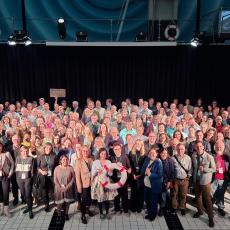Switzerland and Oregon, though culturally and geographically distinct, practice democracy in surprising similar ways, and with surprisingly different results. Oregon is four times larger than Switzerland, yet it has a population that is about one-third the size, writes Brynne Webb from Ashland/Oregon.
Switzerland has 26 cantons, which are jurisdictionally similar to counties in Oregon. Initially, democracy in Switzerland was primarily canton-based, and the Swiss conducted elections in a way that resembles current Oregonian politics at the county level. Since 1848, Switzerland has developed a highly participatory direct democracy, which inspired Oregon to adopt a similar political approach. In 2011, the Oregon legislature passed a law making the Citizen´s Initiative Review a permanent part of the electoral process, just as it has been in Switzerland since 1891.
Both Swiss and Oregonian citizens have the ability to utilize the initiative process to change their respective constitutions. Initiatives in both Oregon and Switzerland require a predetermined number of signatures, to be collected within a certain time frame, for certification by their respective governments. Modern direct democracy has an unmistakable impact on voter satisfaction and political participation. According to “Modern Direct Democracy in Switzerland and the American West” (mdd-in-ch-and-american-west_2012), written by Joe Mathews and Bruno Kaufmann, Swiss citizens were asked to rank their satisfaction with their government. Roughly 65% of them gave a seven or higher, on a scale of one to ten, and only 2% put a 0 or one.
Voter turnout and happiness
This high rate of contentment does not necessarily correlate to a high voter turnout in Switzerland. According to International IDEA, Swiss voter turnout in 2015 amounted to only 48.4% of the eligible electorate. Americans, who were far less happy with their government and laws, saw voter turnout top out at 42.5% in 2014. This brings up an almost cyclical connection between voter happiness and apathy. The happier the citizens, the lower the turnout. As happiness starts to lower, the trend shows that more people vote, until the happiness hits an extreme low, at which point voter apathy increases. In a typical year, the Swiss are called to an official vote on a quarterly basis. In addition, citizen initiatives and referendums occur faster and more frequently than in the US.
Consequently, Swiss democracy is so highly participatory that happiness and apathy have a positive correlation, meaning the Swiss are so happy with their government and laws that they see no need to vote to change the status quo. One could conclude that the more voice the people have, the less often they turn out for regular elections. This phenomenon can be seen in reverse in the US. Elections in the US occur every four years for president, every two for members of the House of Representatives and senators (who serve six-year terms), and usually every four years in gubernatorial races.
Even if local municipal elections are included, the most times a US citizen will vote in a given year is three, if all of those dates coincide. While direct democracy is practiced in Oregon, it is not established within all 50 states. Due to this fact, voter satisfaction tends to decrease while apathy rises.
Limitations
Direct democracy, while increasing voter fulfilment, has several limitations that can cause controversy within a nation and even internationally. For example, over the past decade the Swiss have been criticized by their European Union neighbours for citizen initiatives that are contrary to international regulations or laws. To date, four citizen initiatives have been found to conflict with international law. Most recently, the citizen initiative titled, For a Sensible Asylum Policy, was invalidated by the Swiss parliament for violating mandatory laws regarding the non-expulsion of refugees [in 1996]. Direct democracy in Oregon has no authority over international law, but it can cause conflict between the state and the federal government. This is showcased by the legalisation of marijuana in Oregon.
Though direct democracy is appealing and functional at a statewide level in the US, it would be difficult to implement it at the federal due to differing geographical and time-sensitive needs. Each of the 50 states has its own constitution (which only can be changed by a popular vote), however, only the half of states allow citizen´s initiatives (24) and referendums (23), and critics argue that direct participation undercuts the functionality of governmental representation.
Circumvent power
Representative government gives elected officials the power to create and adopt policies and directives. Opponents of direct democracy argue that by allowing initiatives and referendums, the people are able to circumvent their power and directly create and adopt legislation. While American government is considered a democracy, a population of 318.9 million people, with an electoral college that speaks for the majority, makes it difficult for voters to feel as engaged on a federal level as Swiss citizens do.
So what can we learn from the Swiss political system that Oregon replicated, at least in part? Swiss politicians are relatively obscure. They are not high-profile figures, even in Switzerland.Instead, the Swiss electorate focuses on issues. Perhaps the greatest lesson is that two national political structures can be comparable, resulting in similar levels of voter turnout, but can create vastly different levels of voter satisfaction.
By Brynne Webb is a sophomore chemistry major and Honors College scholar at Southern Oregon University. This piece was originally published by the Oregon-based Ashland Daily Tidings



